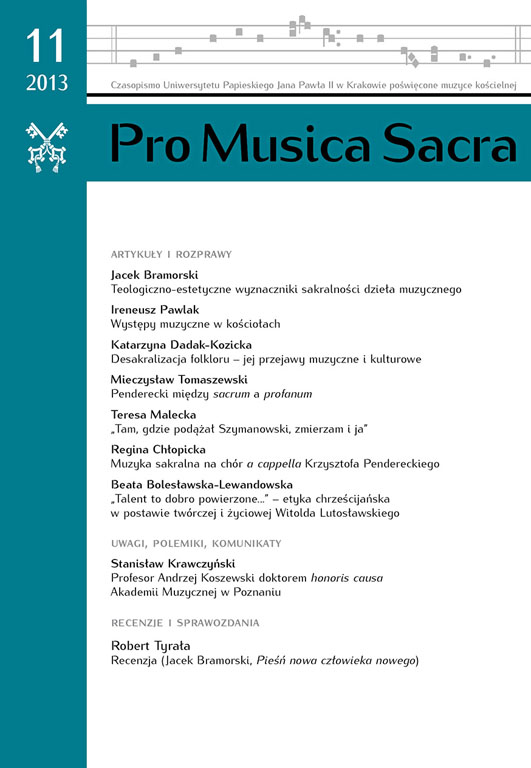Theological requirements for the place of liturgical celebration
DOI:
https://doi.org/10.15633/pms.553Keywords:
sacred edifice, consecration of the church, qualities of a church buildingAbstract
Talking about music in a sacral space is without doubt necessary to look deeply into the meaning of church building itself. Purpose for which is serving, formats its structure and equipment. In the article reflection was founded on the testimony of christian community of the first centuries and on the texts in the present Pontifical, which is used during dedication of the church and the altar. Christians in the first centuries during designing of the churches distains themselves from pagan buildings and also from the Temple in Jerusalem. They emphasize the spiritual side of their worship. They needed only the building where they could meet together, because the community was the real temple of God. So they gather simply very often in a bigger house or sometimes in a synagogue.
The building of the church in a landscape of the towns and villages is undoubtedly the sign. It says by itself about unceasing God’s care for human being. The mystery of Incarnation is the base of the truth that God reveals Himself in a creation. That’s why for believers, although not only, it is the place of the presence of God who saved man. The community lives by celebrating, and they are hold in the church. Church becomes the sign of close relation between God and man.
Today is required that the church building should have all what is necessary for celebration. Only that building can be blessed and serve for christian cult. The most important elements of equipment are altar, pulpit and place for leading. It is also necessary to notice and have the proper place for organ, choir and acoustic. Undoubtedly the mark of the church should be inert noble beauty.
The sanctity of the church building depends on mystery of the presence of God in certain place. Through holding in it the sacred rites it becomes holy but it can lose holiness if it is used for different purpose.
Downloads
Published
Issue
Section
License
Copyright (c) 2013 Stanisław Mieszczak

This work is licensed under a Creative Commons Attribution 4.0 International License.
Authors who publish with this journal agree to the following terms:
- Authors retain the copyright and full publishing rights without restrictions, and grant the journal right of first publication with the work simultaneously licensed under a Creative Commons Attribution 4.0 International License that allows others to share the work with an acknowledgement of the work's authorship and initial publication in this journal.
- Authors are able to enter into separate, additional contractual arrangements for the non-exclusive distribution of the journal's published version of the work (e.g., post it to an institutional repository or publish it in a book), with an acknowledgement of its initial publication in this journal.
- Authors are permitted and encouraged to post their work online (e.g., in institutional repositories or on their website) prior to and during the submission process, as it can lead to productive exchanges, as well as earlier and greater citation of published work (See The Effect of Open Access).

